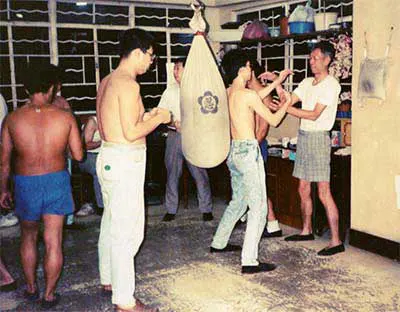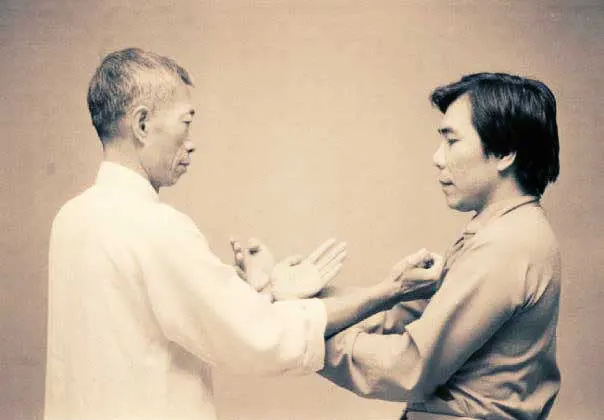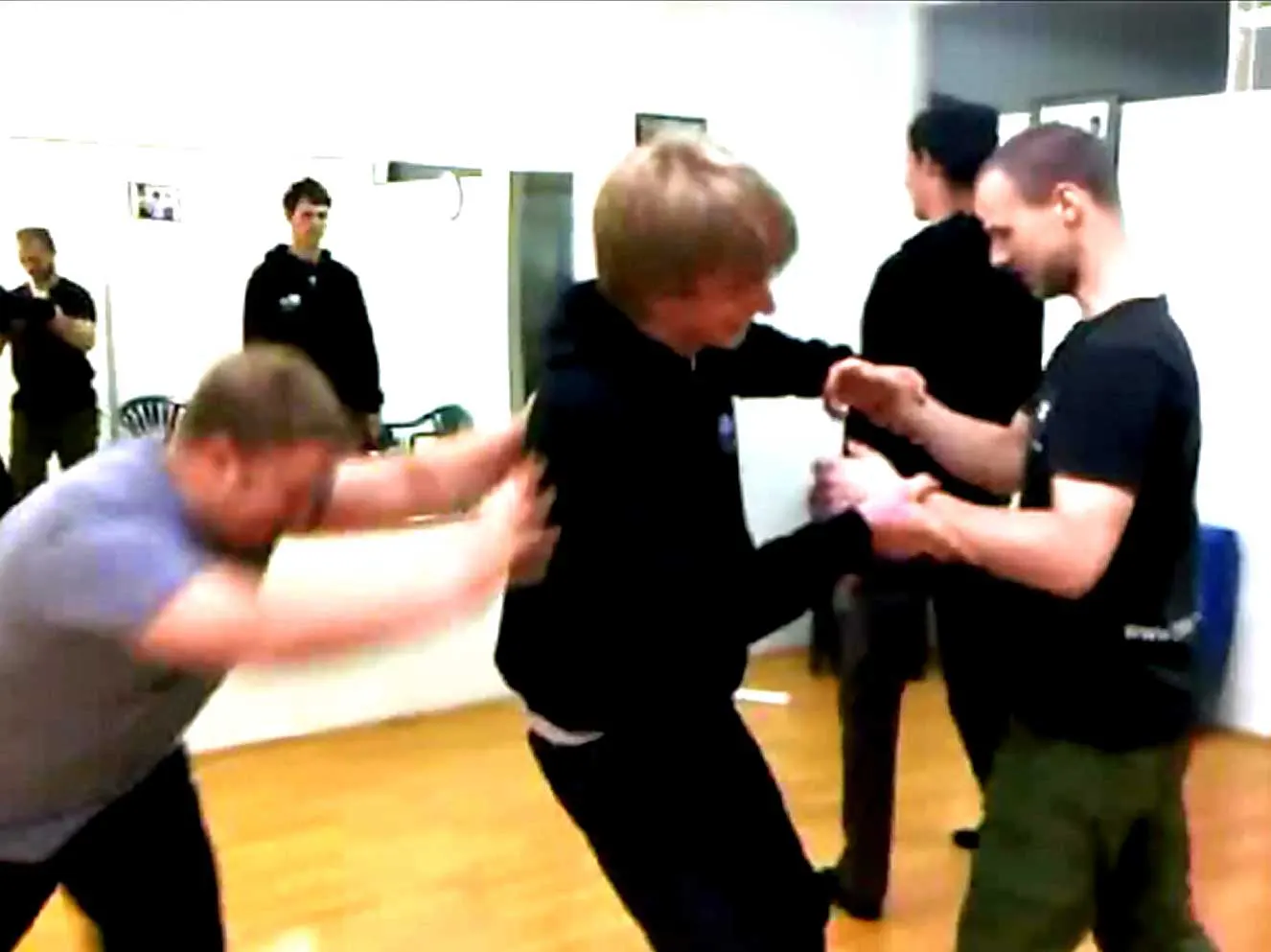Chi Sau (Sticking Hands) Part 1

By Chu Shong Tin
Chi Sau (Sticking Hands) is the necessary step in learning the fighting principles of Wing Chun. The purpose is to train the application of the movements and the ingenious responses in fighting so one can foster the natural reflexes of the movements.
In order to develop the superior, natural and habitual reflexes, one needs to have a rigorous basis in sticking hands training. Because of this reason, the practice of sticking hands is divided into the following stages: single sticking hands, rolling hands, practicing the defending and attacking techniques and free sparring and they require step by step learning.
When some practitioners discuss Wing Chun’s Sticking Hands practice, they consider that the techniques in sticking hands are effective only when there is arm contact with the opponent. The Wing Chun practitioner can then feel what the opponent is doing, respond to the action and fight back. In fighting, if the opponent can avoid arm contact with the Wing Chun practitioner then they think the function of sticking hands cannot be used. This idea is due to their lack of understanding in Wing Chun.
Sticking hands does not need arm contact in its response to the action of the opponent. The purpose of sticking hands is diverse and its skills need to be coordinated together in order to achieve the best fighting result.
The procedures and purposes of sticking hands can be divided as follows:
- Single Sticking Hands
- Rolling Arms (also called Rotating Arms)
- Practicing defending and attacking techniques (called Double Sticking Hands)
- Application of force (No actual force is required but it is difficult to find a proper phrase to replace it)
- Establish and utilize the natural subconscious reflexes of “Loy Lau Hoi Shun, Lut Sau Ja Chung” (Means: when a person strikes in, one should neutralize his incoming force. When his force is withdrawing, one should move in. When he removes his hand(s, one should strike in.)
- Seek the profound techniques of facing one’s shadow, chasing one’s shadow and pointing towards the centre line.

Single Sticking Hands
It is the first step in learning the sticking hands of Wing Chun by practicing how to use the defending and attacking techniques of Tan Sau, Bong Sau and Fook Sau. Generally, beginners will find it difficult in using Tan Sau and Bong Sau when they receive a downward pressing force from the opponent. They will feel that the application of force in Fook Sau has a dominant advantage over the other movements. However, if one can understand the rotational skill of Tan Sau and Bong Sau, not only can he intimidate the one using the Fook Sau but he can also tire out that person very easily. In contrast, if the person can utilize the Fook Sau properly, he can tire out the user of Tan or Bong Sau and make it difficult to withstand his force. This is a contradictory matter, however the one who can apply the movements best will succeed.
Rolling arms
Both sides try to practice with the Tan Sau, Bong Sau and Fook Sau to form a circular rotating movement. This results in the skills of redirecting force, applying pressure to the opponent, withstanding pressure from the opponent, unbalancing the opponent by using correct technique and developing completely relaxed shoulder joints even when one is under pressure. If one can relax their shoulder-joints more, the force from the initial sliding movement of the joints will increase which will lead to an accelerated rotational movement, hence creating successful tractive and striking forces.
Practicing defending and attacking techniques (Double sticking hands)
During Double Sticking Hands, one can use the defending and attacking techniques freely. The defending and attacking techniques are divided into three learning stages:
- Siu Nim Tao
- Chum Kiu
- Biu Jee
As for the Wooden Dummy techniques, the movements are derived from combinations of the three empty hand forms and uses the dummy as a partner to practice on.
- Siu Nim Tao stage:
Each side will practice the defending and attacking techniques in a nearly stabilized position (a slight forward or backward movement is allowed). Both sides will use the Tan Sau, Bong Sau and Fook Sau to sense the attack and respond with a proper defending and attacking movement, e.g.
- “Tan Da” – rotates from Bong Sau to Tan Sau together with a strike;
- “Jut Da” – a quick strike-in movement;
- “Pak Da”- one hand controls the opponent’s contact hand and removes his remaining hand by using the Pak Sau to allow the free hand to strike in;
- “On Da” – affects one of the opponent’s contact hands with one hand and strikes in with the other hand;
- “Yat Fook Yee” – controlling both hands of the opponent by using Lap Sau and uses the free hand to strike; etc.
- Chum Kiu stage:
When practicing sticking hands with the Chum Kiu movements, one should first understand the purpose of the Chum Kiu form. The purpose of Chum Kiu is to transfer the power generated from the movement of the body mass to the techniques. Although the techniques used are nearly the same as in the Siu Nim Tao, each movement (defending or attacking) will be supported by the body mass, e.g. moving forward or backward, pivoting, etc. This will increase the power of the techniques.
- Biu Jee stage:
Biu Jee is the form which concentrates an enormous destructive power in attacking. For training purposes, in order to prevent the chance of hurting each other, Biu Jee is seldom used in sticking hands because the techniques of this form can accelerate the power of the body mass to the striking point. Even a slight contact between the hands can produce damage to the opponent. Therefore, explanation and demonstration under proper control will be used to show the way of practicing Biu Jee techniques in sticking hands.
Application of force
During sticking hands, the direction of force from the opponent will vary constantly. One should alter his force to counter the changes by using the techniques of facing one’s shadow, chasing one’s shadow, circular rotations, forward and backward movements, etc. and develops the feeling of how to use the right technique at the right time to upset the balance of the opponent. This will store the most effective ways in one’s mind and create the subconscious reflexes for fighting. This enables a practitioner to apply the best technique as a natural subconscious response.
Establish and utilize the natural subconscious reflexes of “Loy Lau Hoi Shun, Lut Sau Ja Chung”
It is not easy to develop the skill from this motto of Wing Chun. “Loy Lau Hoi Shun, Lut Sau Ja Chung”. If one uses the sense of sight to feel the direction of the force of the opponent and then respond by neutralizing the incoming force or attack the withdrawing force, then this has not the true skill of “Loy Lau Hoi Shun, Lut Sau Ja Chung”. The responses to the sense of sight are very slow and they cannot achieve the desired result.
Rather than relying on the sense of sight, the subconscious reflexes will respond instead. To develop this faculty one should concentrate on training “the sense from brain”. This is the same “Mind Force” (Nim Tao) as used in the Siu Nim Tao to maintain the elasticity of the joints in the body. By coordinating the springy arms and the mind force together and focusing to the weakest point of the opponent’s structure, one will develop the direct reflexes of the subconscious mind and reach the original aim of “Loy Lau Hoi Shun, Lut Sau Ja Chung”.
Seek the profound techniques of facing one’s shadow, chasing one’s shadow and pointing towards the centre line
The purposes of facing one’s shadow, chasing one’s shadow and pointing towards the centre line have already been explained (see previous notes). Therefore, in practicing sticking hands, one should concentrate on its feeling and try to comprehend its practical value and skill in order to understand its real purpose and worth.

Learn More about Chi Sau (Sticking Hands)
By Chu Shong Tin